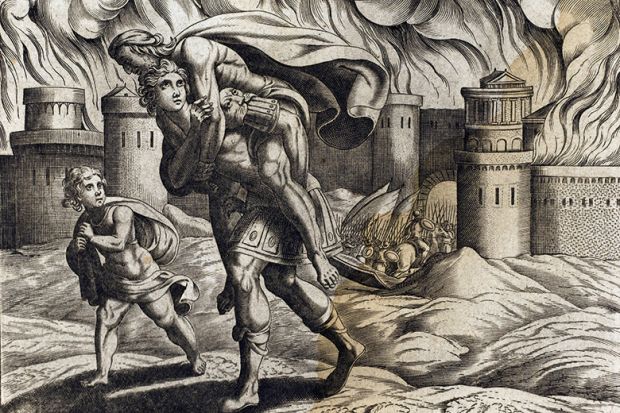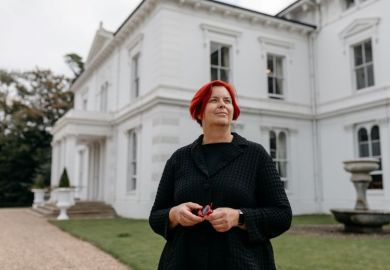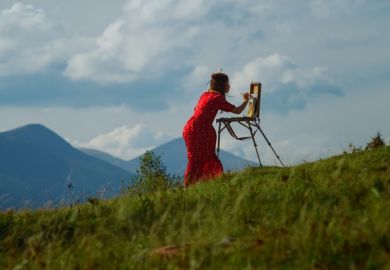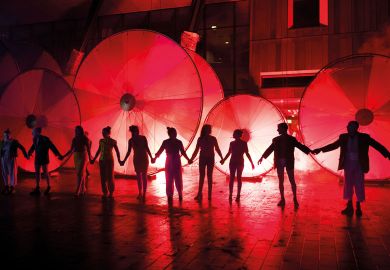As the impetuous Olivia, in Twelfth Night, attempts to bestow upon her reluctant wooer an image of herself, she reassures him that mere semblances are dumb: “wear this jewel for me, ’tis my picture –/Refuse it not, it hath no tongue to vex you”. John H. Astington’s Stage and Picture in the English Renaissance is an intriguing, if not always convincing, attempt to demonstrate the vocality of images: tapestries, woodcuts, engravings, paintings. He argues that the ubiquity of images (sacred, secular, mythological, political) often impacted on the reception of the living pictures of the theatre: “sixteenth- and seventeenth-century English audiences were surrounded by a rich visual culture, and came to the playhouse informed by it”.
For instance, the pervasive image of Aeneas bearing his father, Anchises, on his shoulders from the ruins of Troy, is directly alluded to by Young Clifford carrying the corpse of his father in Henry VI, Part 2: “As did Aeneas old Anchises bear”. But, Astington suggests, it also resonates visually and without mention of its source as the elderly Adam is carried onstage by Orlando in As You Like It.
This resonance is reinforced by the period’s fetishising of imitatio, “a framework of repeated motifs, symbols, and generic expectation”, a mode of classical simulation unsurprising in a period that thought of itself as a re- naissance of ancient wisdom. Ekphrastic poetry (ie, verbal renderings of the visual such as Lucrece’s disquisition on the painting of the Trojan War in Shakespeare’s The Rape of Lucrece) and the philosophical analogy of poetry and painting that underlined the emulation of the Horatian principle ut pictura poesis (surprisingly not mentioned by Astington) reinforce his suggestion that the two art forms may have been conceived as being much closer than they are today. Indeed, the early modern “emblem book” – a genre hardly recognisable in modern times – typifies the symbiosis between verbal and pictorial, described incisively by Astington as a “form of expression in which language and picture are in dialogue, a kind of graphic poem”.
There is no doubt that visual and verbal, pictorial and linguistic, interpenetrated each other to a large extent, but Astington’s claim that this might offer a way of appreciating an early modern audience’s interpretative responses to Elizabethan theatre remains unconvincing. To begin with, many of the tapestries that he describes were not likely to have been seen by Globe-goers: of the rich iconography of Richmond Palace, Astington concedes, “Such a display was hardly on public view”.
While tapestries depicting Cleopatra’s barge or Volumnia meeting Coriolanus have features in common with Enobarbus’ lyrical description or the staging of mother and son in Shakespeare’s Coriolanus, these artefacts were much too valuable to have been on communal display and, although Astington points out that pictorial hangings may well have made up part of the extravagance of Lord Mayor’s pageants or Christmas and new year festivities, the number of Shakespeare’s audience who may have seen them is, at best, indefinite. Astington can only justify the tantalising possibility: “Perhaps Shakespeare thought of the scene [between Coriolanus and Volumnia] in terms of the pictures he may have seen.” This is a handsome and generously illustrated book but it does little more than “raise a wide field of questions”.
Peter J. Smith is a former trustee of the British Shakespeare Association and reader in Renaissance literature at Nottingham Trent University. Most recently, he is the co-editor (with Deborah Cartmell) of Much Ado About Nothing: A Critical Reader in Arden’s Early Modern Drama Guides (forthcoming).
Stage and Picture in the English Renaissance: The Mirror up to Nature
By John H. Astington
Cambridge University Press 280pp, £75.00
ISBN 9781107121430
Published 18 May 2017
Register to continue
Why register?
- Registration is free and only takes a moment
- Once registered, you can read 3 articles a month
- Sign up for our newsletter
Subscribe
Or subscribe for unlimited access to:
- Unlimited access to news, views, insights & reviews
- Digital editions
- Digital access to THE’s university and college rankings analysis
Already registered or a current subscriber? Login




